How brands can get more value from personalisation (with Optimizely)

In today’s business landscape, personalisation is no longer a strategic choice—it’s a must.
As much as 76% of consumers say that personalisation is a key factor in their purchasing decisions. Additionally, personalisation has also been linked to a 50% reduction in customer acquisition costs and up to an eight-fold increase in return on marketing spend.
Despite the massive push across industries towards personalisation, however, over 60% of marketers are struggling with it. So, what makes personalisation so hard to get right?
Throughout our experience as an Optimizely Platinum Partner, we’ve identified three key areas for improvement.
Strategy: planning for a marathon, not a sprint
One of the most common obstacles we’ve observed is the absence of a well-defined personalisation strategy. For personalisation to be effective, it needs to be applied and integrated across every aspect of your brand—from data to UX, design to technology.
However, while the overall impact of personalisation depends on how it is applied within these individual aspects, the direct impact on each one is tough to quantify. As a result, it’s all too easy for the specific initiatives around personalisation to lose priority as other business opportunities inevitably arise.
To secure comprehensive buy-in and justify continued investment in personalisation, it’s crucial to demonstrate its tangible value. It’s a good idea to begin with a few quick wins—such as those achievable through a DXP—where success can be measured through a set of predetermined KPIs.
Once you’ve accomplished those quick wins, it’s time to pull back and create a strategic approach based on continuous refinement and expansion. Sophisticated solutions like Optimizely Visitor Groups and Optimizely Content Recommendations help make this process surprisingly easy.
- Optimizely Visitor Groups offers a number of inbuilt capabilities that you can use to create variant content blocks that are adjusted automatically based on who is viewing your brand’s site and when. By taking into account criteria like time of day and whether or not a given user has visited other pages on your site, you can foster relevance and browser intimacy.
- Optimizely Content Recommendations gives you the ability to effectively index your brand’s content, providing users with an AI recommendation of content based on what their browser is viewing in real-time. By continuously recommending relevant content, this solution maintains users’ interests much like “Discover” tabs on social media do, helping reduce bounce rates from your brand’s site.
As you gain deeper insight into the customer journey and a more granular understanding of your customer base, you can hone your strategy even further to manifest exponential improvements in customer engagement, conversion rates, and growth.
Skills and teams: creating a unified front
Another significant hurdle brands encounter is the shortage of necessary skills and knowledge to execute personalisation campaigns effectively—even when they have the right tools and technology.
From an organisational perspective, for example, a siloed approach to personalisation can restrict knowledge-sharing and limit the scope of an initiative to the speciality of one department.
To drive the best results with personalisation, you need to establish a unified front. By assembling a multidisciplinary team with specialists from across the full spectrum of your organisation, you can work together to assess the full customer journey and create use cases for personalisation that address specific needs.
At the same time, it’s also important to build accountability into your team by assigning a designated person or group to oversee everyone’s efforts and ensure they remain a priority.
In this regard, Optimizely’s Content Marketing Platform can offer a valuable contribution to your brand’s multidisciplinary personalisation team:
- Optimizely Content Marketing Platform (CMP) is used to plan, build, and execute campaigns. Through a set of AI-enabled tools for generation, collaboration, validation, and more, CMP streamlines operations by helping teams monitor progress and maintain accountability.
Data: fostering structure to gain insight
While businesses amass vast amounts of data, they often lack a structured method for extracting insights, taking meaningful action, and evaluating impact.
This is where the value of a Customer Data Platform (CDP) comes into play. Without one, the lack of structure will be reflected in the quality of your data. Even if you’re relying on multiple tools in lieu of a CDP, the lack of integration will lead to the same issue.
Ultimately, the bottom line is that achieving any significant value from personalisation hinges on a deep understanding of your customer base.
This requires going beyond basic demographics to truly comprehend your customers’ needs, behaviours, and preferences. This is where solutions like Optimizely Data Platform can make a huge difference in your customer comprehension.
- Optimizely Data Platform (ODP) is a CDP that provides real-time segmentation and an assortment of other inbuilt campaign mechanisms, all by serving as a single source of truth for collecting, organising, and analysing your brand’s customer data.
- Optimizely Campaign is one example of an Optimizely solution designed to integrate with ODP. By syncing Campaign with ODP, you can automate marketing campaigns and personalize them based on audience attributes.
Another often overlooked way of gaining this insight is through qualitative research, such as customer interviews and user testing.
Combining those qualitative answers with CDP-enabled quantitative data analysis empowers your business to construct a comprehensive customer segmentation strategy. This understanding facilitates the development of more targeted and impactful personalisation initiatives.
Unlocking the last mile of value
We collect more data than at any point in history, but businesses rarely have a systematic approach to crafting insights from data, taking meaningful action, and closing the loop by measuring the impact.
That’s why we’ve based our approach to personalisation around these four fundamental pillars: Data, Insight, Action, and Impact.
This approach uses a structured process to ensure you’re not only building an understanding of your customer base through data analysis and insight generation, but also implementing those insights strategically to create a measurable impact.
Ready to supercharge your own personalisation strategy? Learn more about our capabilities as Optimizely Platinum Partners.
Meet us at Opticon 2024!
We’ll be in London, San Diego, & San Antonio
Questions?
Principal Digital Consultant, OMVP
Joe Watson
More insights
Achieving super-powered personalisation in financial services with CDPs

Let’s talk about Iron Man—or, more specifically, JARVIS, the assistant that’s always in his ear.
Short for Just A Rather Very Intelligent System, Marvel’s depiction of JARVIS represents a serious upgrade from his original, human namesake: This JARVIS is powered by AI.
Like Iron Man, in the Age of AI, businesses within the banking, financial services, and insurance (BFSI) industry are getting their own, newer, better JARVIS.
The customer management tools once known as Customer Data Platforms are quickly evolving into something much more sophisticated and powerful—something that will prove invaluable to businesses as delivering on the promise of hyper-personalisation becomes the name of the game.
The need for personalisation
Faced with the threat of imminent global destruction, JARVIS’s upgrade couldn’t have come at a better time for Iron Man and the rest of Marvel’s Avengers.
With the BFSI industry standing on the threshold of its own defining transformation, CDPs likewise represent a valuable asset in preserving humanity—or, rather, preserving the human relationships that have long characterised the industry.
As part of the next wave of digital transformation, businesses within the BFSI industry need to strike a balance by humanising digital interactions. This means moving away from simply delivering your products via a digital funnel and instead focusing on the bigger context and the outcomes your customers want to achieve.
How do you discover what your customers want to achieve? The go-to answer among customer experience experts within the BFSI industry has long been a good ol’ fashioned customer survey. However, the challenges of customer surveys have been well documented.
- On average, just 7-10% of a business’s customer base will complete a survey.
- Surveys are inherently limited by a specific set of questions. As a result, businesses will miss out on valuable customer feedback on topics not covered in the survey.
- The one-off nature of surveys makes it exceptionally difficult for businesses to resolve issues proactively. Instead, they are forced to respond to issues as they happen.
According to McKinsey, leveraging an analytics-driven customer feedback system—such as a CDP—enables you to overcome these challenges and harness the power of data to dramatically improve personalisation within your business.
Pushing the bounds of personalised marketing
Iron Man’s power comes from his robotic suit. But it’s JARVIS’ real-time feedback and recommendations that enhance that power and define Iron Man as a superhero.
With an almost unmatched amount of first-party customer data at their disposal, businesses within the BFSI industry are in much the same position: They have the power to create highly effective customer personalisation, all that’s missing is the added edge that comes from a CDP-driven insights.
CDPs consolidate and process customer data, including demographics, behaviour, and transactions, to create a single, unified customer view. This allows banks to understand each customer’s needs and behaviours to go a step beyond traditional marketing and interactions with the following:
- Creating informed product recommendations. By using a CDP to analyse customer data like browsing behaviour and credit card transaction histories, you can generate hyperpersonalised product recommendations. For example, a CDP for a bank could help create a set of informed credit card recommendations for customers based on their individual needs. This could take into account everything from their current salary and credit history to their shopping behaviour and saving habits.
- Optimising marketing and communication strategies. As mentioned, different generations have different preferences when it comes to communication channels. To target customers more effectively, you can use a CDP to segment customers according to the channels they frequent the most and personalise their individual customer journey even further.
- Enhancing cybersecurity and risk management. The rise of AI is a double-edged sword: Identity theft and identity fraud have increased dramatically and, recently, Jamie Dimon, CEO of JP Morgan Chase, identified cybersecurity as the biggest threat facing the financial services industry. Fortunately, a CDP can help you and your business detect fraud by monitoring customer transactions and behaviour for any abnormalities. Even more exciting, by harnessing the power of machine learning and AI, CDPs can also analyse historical data to perform fraud pattern analysis and provide insight into any vulnerabilities within your business.
In these ways, the right CDP helps you increase the value of your customer offerings directly with hyperpersonalised benefits that can be realised in real-time.
Enhancing operational efficiency
It’s with JARVIS assistance that Tony Stark runs the business behind Stark Industries, enabling him to spend more of his time protecting humanity as Iron Man.
Likewise, CDPs boost the operational efficiency of financial and insurance-related organisations by automating data management tasks and facilitating predictive analytics, creating the opportunity for businesses to focus on a new era of innovative personalised customer offerings.
Many organisations within BFSI, have cultivated the kind of distinguished reputation that can only come from a decades-long history. At the same time, longstanding institutions like these face a major roadblock as technology continues to advance: A lack of data hygiene and strategy.
In our experience, BFSI organisations excel at data collection. However, in order to leverage technology like AI, the quality of the data is key—not just volume. According to Accenture, the success of Generative AI in banking is contingent on a strategy that puts focus on data strategy and cloud infrastructure.
This is where CDPs can excel. They can improve data quality by deduplicating, validating, and cleaning data upon ingestion, which ensures high-quality data for marketing campaigns and other business operations. They also standardise data attributes for consistent use across different banking systems.
Most importantly, by creating unifying data and pulling together a comprehensive view of it, CDPs enable you and your business to:
- Improve operational efficiency. By automating tasks like data integration, segmentation, and personalisation, CDPs can free up your team’s time to focus on more complex tasks, such as advising customers or developing new products and services. In turn, you and your team can use the insight of a CDP to enhance your own capability. For example, by offering more informed and personalised financial advice.
- Predict customer churn. Using machine learning, CDPs can help you analyse customer behaviour to identify those who are likely to switch to a competitor. This enables you to target these customers accordingly, leveraging the more personalised offerings discussed in the previous section.
- Identify upselling and cross-selling opportunities. In addition to identifying potential customer churn, CDPs can also identify opportunities to sell additional products and services both by drawing upon customer data and by conducting cohort analysis. For example, a bank could segment those customers who are most likely to repay a loan and earmark them for additional services.
A more intelligent path forward
As any Marvel aficionado already knows, JARVIS’ role eventually evolves far beyond that of personal assistant to Iron Man. After being uploaded into his own android body, JARVIS becomes Vision, a superhero in his own right.
As CDPs continue their own evolution, it won’t be long until they evolve into something new as well. It’s not unrealistic for CDPs to be rebranded from “Customer Data Platforms” to “Customer Intelligence Platforms.”
By harnessing the power of CDPs, banks and other financial institutions can transcend basic customer interactions to achieve unprecedented levels of personalisation and operational efficiency.
Moreover, it’s clear that in an increasingly AI-powered landscape, CDPs—or, rather, CIPs—will only become more and more critical in ensuring sustained loyalty and competitive advantage in the market.
Questions?
Director of Data, CRO & Insights
Matt Lacey
The next stage of frictionless banking experiences: aspiration and personalisation

Over the past decade…
Brands in all industries have obsessed with creating frictionless digital experiences. This is especially true for banking.
The idea of a frictionless experience began with simple optimisation techniques and exceptional UI. But as benchmarks are repeatedly set and met, banks must take the next step toward frictionless experiences—beyond a pretty interface.
The next wave of frictionless banking is focused on: “How do you make banking feel so integrated into the customer experience that users no longer recognise they’re working with a bank?”
The future of the banking experience involves integrating financial institutions into people’s everyday lives. It’s no longer enough to be perceived as a secure institution to store money. For banks to succeed in the future, customers must see them as personalised advisers, helping them maximise time and money while reaching individual goals.
While this sounds challenging at face value, organisations can take incremental steps to move toward this new, frictionless era.

Analysing friction
Every bank should participate in a recurring friction analysis, a workshop where you define friction touchpoints and explore how you might mitigate them.
This involves identifying pain points, bottlenecks, and areas of customer dissatisfaction across all your touchpoints—mobile apps, websites, physical branches, and even social channels. Bring user feedback, analytics, and customer journey mapping into it so you can understand the specific areas that need improvement.
During the friction analysis, focus on streamlining processes, simplifying user interfaces, and optimising the overall user experience. This probably involves reducing the steps required to complete transactions, eliminating unnecessary documentation, and improving self-service.
For example, customer handoff is a common moment of friction. If users open a new account at their local bank, they’ll probably access an app within a few hours. Can they log in to their new account with ease, or must they navigate a complicated process?
This kind of scenario mapping can help you find moments of friction and start to prioritise.

Creating a frictionless ecosystem
Once you’ve identified your areas of friction, you must take steps toward a connected ecosystem that integrates digital and non-digital channels. That means customers should be able to start a transaction on their mobile app, continue it on the website, and complete it at a physical branch without any disruption or loss of information.
To accomplish this, you’ll need technologies that enable real-time data synchronisation and seamless integration between channels, including robust backend systems, APIs, data management capabilities, and, most likely, a customer data platform (CDP).
A CDP allows you to collect, unify, and activate customer data from various sources in real time. Any interaction or transaction initiated on one channel is immediately reflected on other channels, eliminating the need for users to repeat information or start over when switching between channels.
For example, if a customer starts a mortgage application on your website but doesn’t complete it, you can send a reminder via your banking mobile app.
For non-CDP organisations, there are some scrappy but efficient alternatives. One is the common QR code, which can direct users to a specific URL on your website. Another might be creating a cookie and sending it linked via WhatsApp.
Bring aspiration into personalisation
The next step into frictionless banking is bringing aspiration into personalisation. In other words, how do you go beyond transactions and offer customers something more? How do you create an “aha” moment?
By leveraging AI and machine learning, you can analyse customer data and understand your customer’s financial aspirations, goals, and preferences—a powerful tool for providing savings plans, investment strategies, or rewards that align with your customer’s aspirations.
For example, if a customer is saving for a home, perhaps you proactively offer a mortgage that fits their needs. If a timely and relevant offer is made, they may expand their relationship with you and allocate more to your products and services.
Beyond obvious financial products, find out how you can fulfil a need, or enhance a new experience. For example:
- Help customers plan a weekend trip by showing activities and deals they can enjoy in a city.
- Encourage a customer who aspires to play more golf with deals on course reservations.
- Reward a movie lover with exclusive merchandise.
If you can help your customers achieve their goals and aspirations within a seamless digital ecosystem, you’ve created a frictionless experience.
Elevating CX in BFSI
The journey towards frictionless banking is an ongoing process that requires continuous improvement and adaptation. As technology evolves, new benchmarks will be set around frictionless experiences.
By continuously elevating your customer experience, you can ultimately improve engagement and share of wallet.
More insights
Audley Travel
Elevating the customer experience with Marketing Cloud Personalisation
In 2023, Audley Travel, a market-leading travel company with a stronghold in the US and UK, found themselves at a crossroads. Well-known for curating tailor-made holidays across 90 countries, the company wanted to provide a more rounded and personalised client experience.

Audley uses Salesforce as their CRM technology of choice, and following a collaborative discovery session between the three organisations, DEPT® (as a Salesforce premium technology partner) proved to be the natural choice to implement Marketing Cloud to revolutionise Audley’s cross-channel marketing efforts. And so we seized the opportunity to mark a transformative chapter in Audley’s email marketing journey.
The objective: re-engaging users
Audley Travel had a straightforward yet ambitious objective: to launch three high-ROI use cases rooted in user website behaviour. Utilising AI-based product recommendations by Salesforce’s Einstein, the intent was to re-engage users who had abandoned an itinerary, a destination, or an enquiry page by sending them a tailored email reminder one day after their initial interaction. These emails were designed either to nudge the user toward completing their booking or to present curated itineraries that aligned with their most-viewed destinations.

Unveiling the power of Marketing Cloud Personalisation
By implementing Marketing Cloud Personalisation, Audley Travel laid the foundation of its first-party data strategy, effectively creating a walled garden of proprietary customer data. This approach not only allows for a nuanced understanding of customer behaviours but also empowers the brand to build powerful user segments for targeted campaigns.
Leveraging AI-driven recommendation systems, each email is dynamically personalised according to user affinities such as destination and itinerary interests, as well as incomplete forms. This personalisation strategy is underpinned by the collection and analysis of user behavioural data across various digital touchpoints, providing valuable insights into the customer journey. Specifically, these touchpoints encompass both our website and email interactions. On the website, we track a user’s behaviour down to the minutiae – what pages they visit, the itineraries they explore, categories and destinations they express an interest in, and even the duration of time they spend on each itinerary. Similarly, within our email campaigns, we closely monitor metrics like email open rates and timestamps to understand the optimal timing and content that resonates with each user.
In doing so, Audley Travel succeeds in breaking down existing data silos, gaining a robust understanding of their customers’ online behaviour and needs, thus setting the stage for a seamless cross-channel experience.

In summary: personalisation meets performance
In just a few months, Audley Travel and DEPT® rolled out a fast, ROI-driven personalisation strategy through Marketing Cloud. This quick implementation met key revenue targets and gave Audley the flexibility to adapt to customer needs and market changes. The project serves as a key milestone, offering Audley an adaptable framework that aligns well with their long-term business objectives that focuses on and improves the overall customer experience.
Explore DEPT®/TRAVEL, our team of specialists pioneering solutions to help travel brands to grow sales, and utilise data & AI to create best-in-class experiences.
Questions?
Marketing Automation Consultant
Alexander Van Rompuy
Discover more
Personalisation at scale with Adobe, smart & DEPT®

When the new smart #1 car launched, they wanted to sell directly to consumers–a big change for the brand.
Their goal was to build brand awareness and entice early adopters. Throughout the campaign, we sought to capture leads by centering the customer journey around search, social, display marketing, and email nurturing.
The result? Increased awareness across a variety of media, increased brand consideration, and increased purchase intent. 11% pre-ordered a #1, three times the industry benchmark.
Listen to the talk below from Adobe, about how smart and DEPT® worked together to drive these marketing wins and set the new standard for personalization at scale. Featuring Praveen Kumar Sadhineni, Lead – CX CoE at Smart Europe and Yash Mody, CTO Global Adobe Alliance at DEPT®
The smart campaign from DEPT®
In 2022, smart went fully electric, rebranding as a leader in the EV market. To kick off this new era, they needed to create excitement around the unveiling, generate leads, and then ultimately convert those leads into pre-orders.
At the same time, they invested heavily in e-commerce. While select dealers would remain, they wanted to sell most of the cars online. This shift in architecture added extra complexities across their tech stack.
With two monumental changes happening simultaneously, smart needed a sophisticated digital marketing strategy and robust technology to support it. Learn more about what strategies we used to help smart transform into D2C.
As an Adobe platinum partner, we can help you personalise at scale.
More insights
Questions about Adobe?
CTO – APAC & DEPT® Adobe Practice
Yash Mody
Strengthening value exchange through personalisation
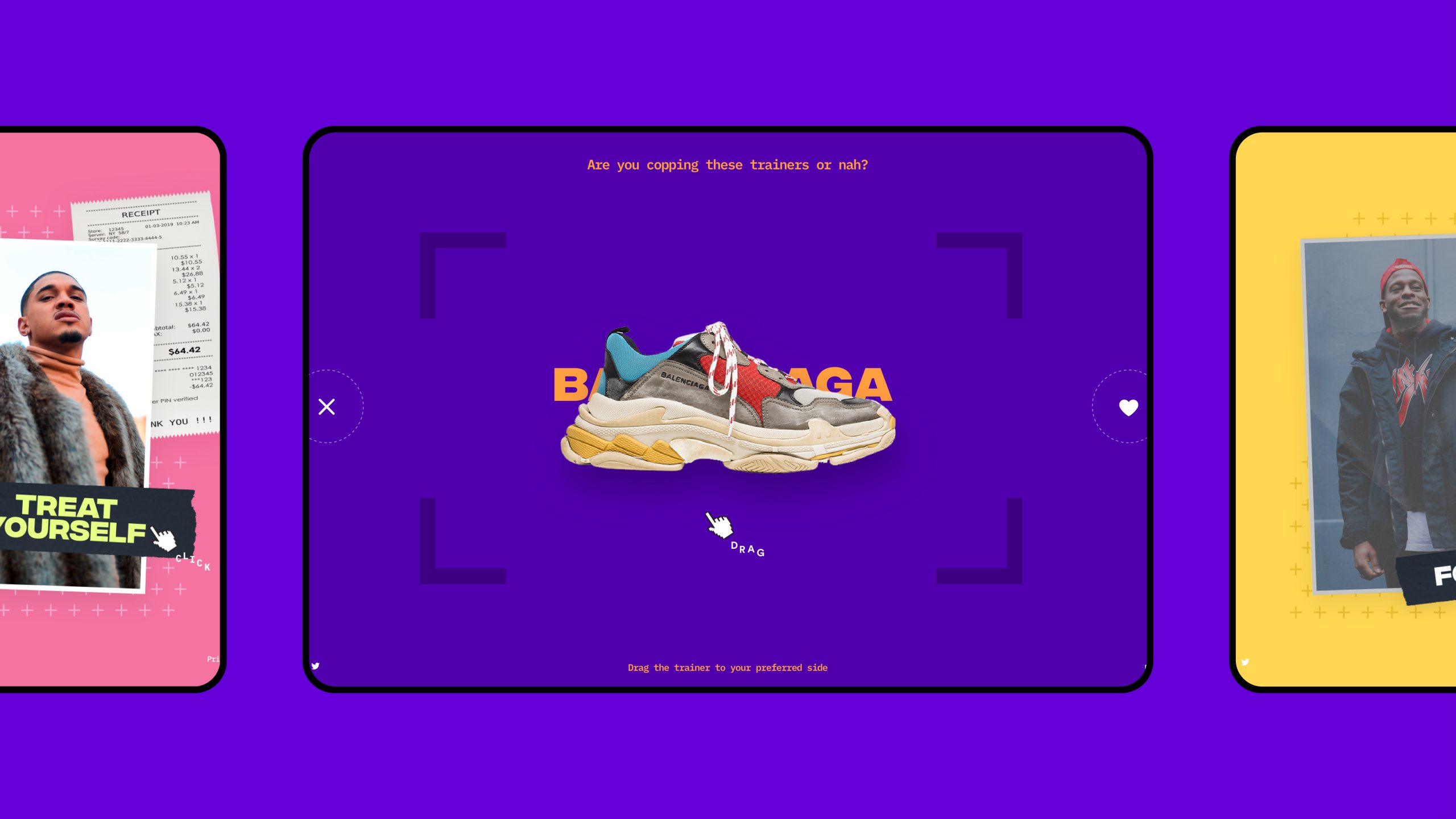

Personalisation is a stalwart of e-commerce, playing a key role in retailers’ digital strategies. It has become even more important as a result of the pandemic, with 75% of consumers trying new store websites and brands during the crisis, leading them to reconsider brand loyalty of where they shop. With competition drastically increasing overnight, e-commerce brands had to up their personalisation game to effectively engage and convert new and returning customers. But are they hitting the mark? We launched a study to find out.
After uncovering what consumers really thought of personalisation in a 2019 survey, we’ve run the study again to see if opinions have changed over the last two years. We found that consumers value personalisation when it is useful to them, and dislike it when they are overtly being sold to; highlighting the urgency for brands to strengthen the value exchange of their personalisation efforts.
Gathering insights
We gained respondents’ views on why they like personalisation by asking them to rate the advantages and disadvantages on a five-point scale of strongly agree to strongly disagree. Sentiment improved consistently across the board, with more people agreeing or strongly agreeing with positive statements about personalisation in 2021 than they did in 2019.
What consumers like the most has stayed the same, with time saving, helping people find new products, or helping them find exactly what they need securing the top three spots. Notably, the biggest increases came from the ‘strongly agree’ ranking, where there was an average 5% increase in the volume of people strongly agreeing with statements.
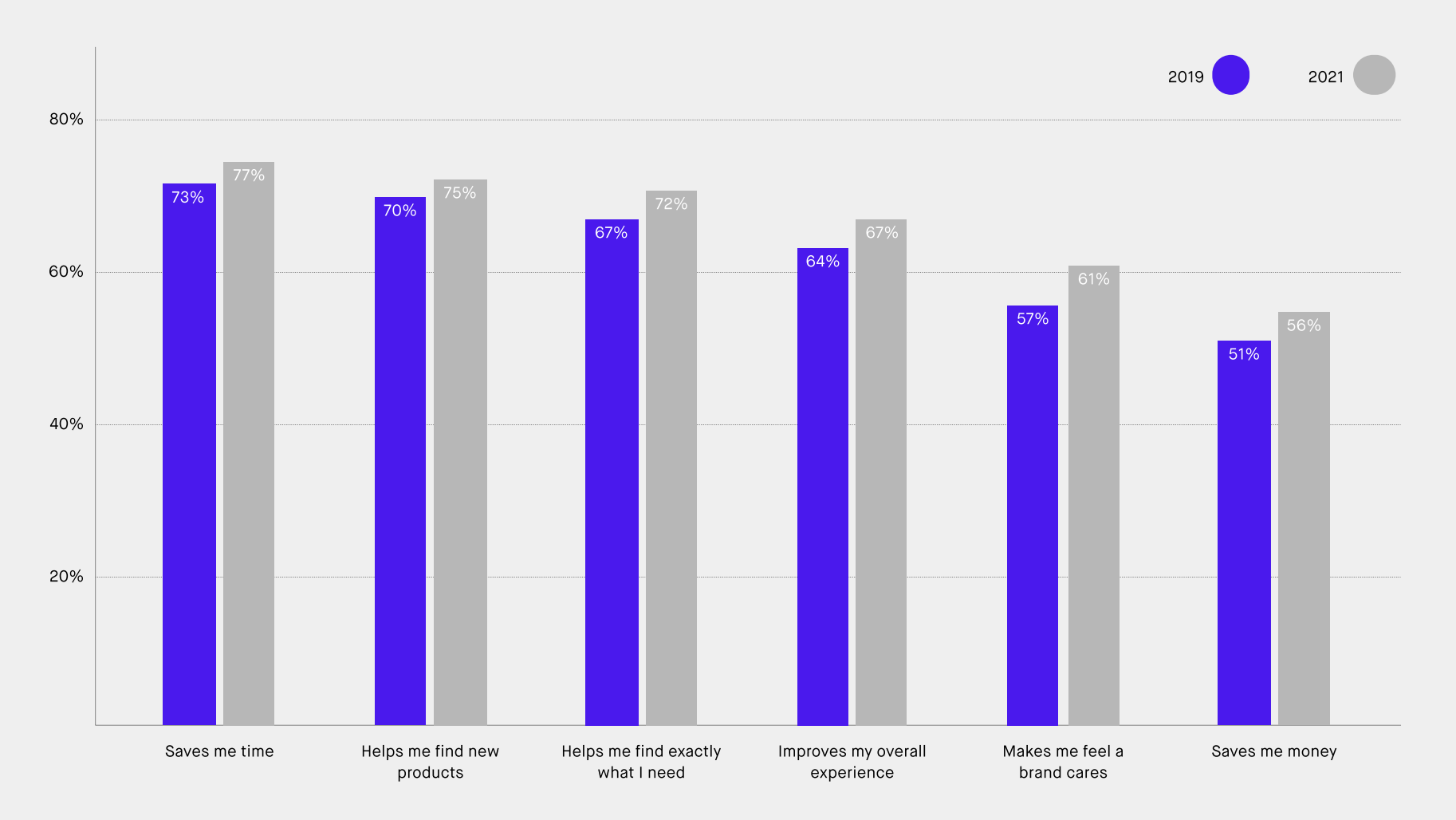
Whereas sentiment has improved for the positive associations with personalisation, it has largely stayed the same when it comes to the reasons people dislike it, with some minor fluctuations for individual statements. The top three reasons why people dislike personalisation are that it can be ‘irrelevant’, ‘creepy’ and ‘unsecure’.
Overall, feelings are strong both for and against personalisation. However, positive sentiment is stronger than negative when reviewing these insights holistically, meaning that consumers like and see the benefits of personalisation more than they dislike it. As in 2019, personalisation is still in the domain of being perceived as both good and bad, suggesting that not enough progress is being made by retailers.
Taking inspiration
The days of personalisation being little more than a first name-addressed email and a ‘happy birthday’ discount are long gone. Digital-first businesses are raising the bar and, in turn, customer expectations. Take Spotify as an example, its daily playlist recommendations and annual ‘Spotify Wrapped’ campaign (recently complemented by its ‘Only You’ campaign), deliver a true one-to-one, personalised experience for users.
These activities are built on data, which is applied in a way that creates an engaging experience for users that isn’t at all perceived as ‘creepy’. The campaigns are also delivered without any immediate conversion, strengthening the value exchange as users don’t feel like they’re being sold to, yet we predict that these activities have a huge positive impact on Spotify’s customer loyalty and retention.
Driving customer loyalty
The e-commerce industry is still some way behind the likes of Spotify, with personalisation efforts being largely focused on short term conversion through email marketing and retargeting methods, rather than how it can benefit brand-consumer relationships in the long term. But in order to catch up, focus needs to be switched to creating a strong value exchange through experience which, in turn, will have a positive impact on sales and loyalty.
The opportunity to strengthen the link between personalisation and loyalty has seen minimal progression between 2019 and 2021. Just 24% of participants said that personalisation makes them more loyal, while the majority (62%) said it makes no difference. Meanwhile, 38% believed personalisation was adopted by brands simply to make them spend more money. Another 39% felt it was to make them spend more as well as make them like the brand more.
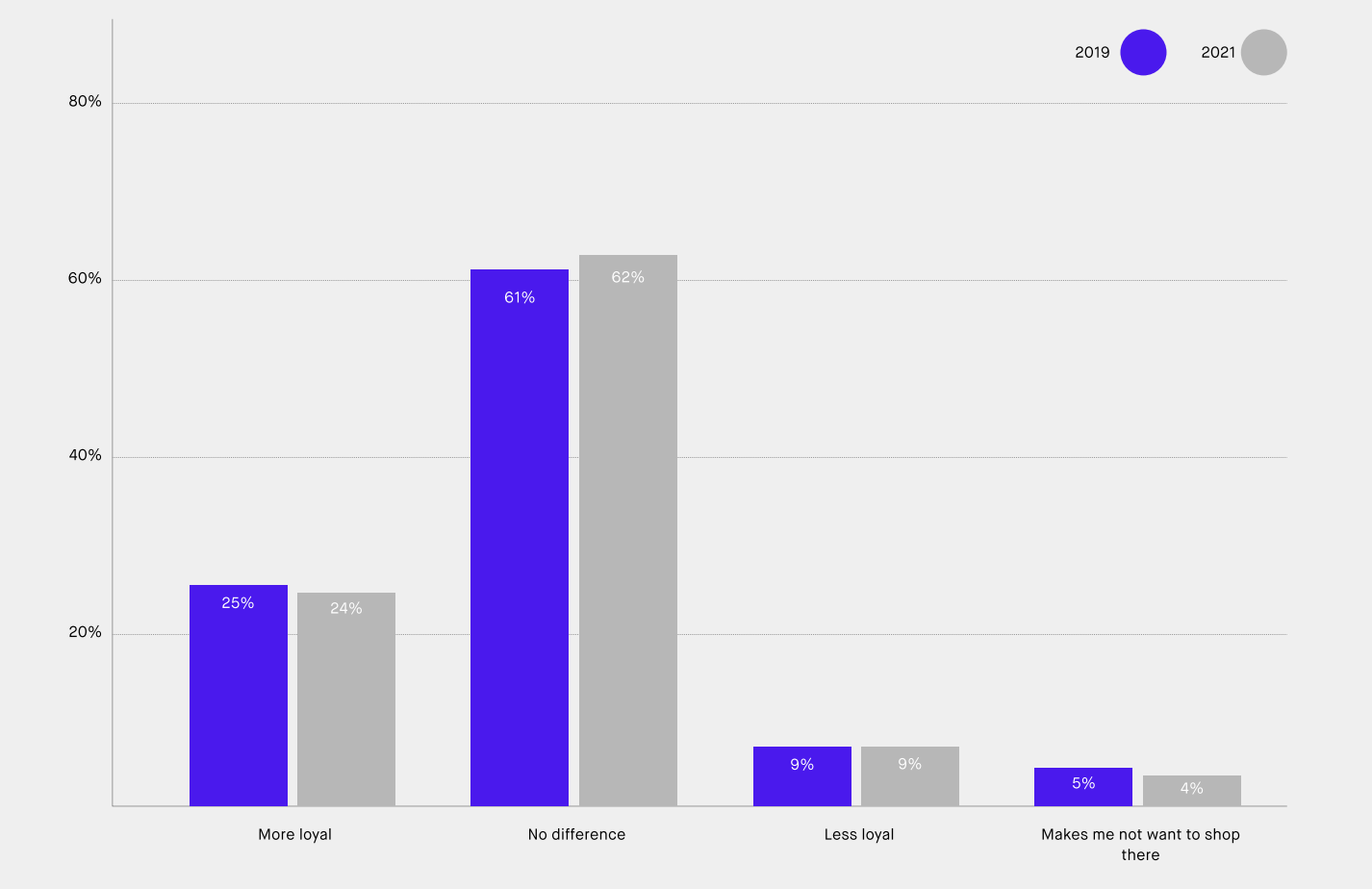
More attention needs to be given to developing loyalty, specifically how the customer experience can impact loyalty, so that customers feel happy about spending money with a company; because they gain something positive in return.
Lizzie Powell – Strategy Director, DEPT®
Getting to know you
With the majority of negative consumer sentiment for personalisation stemming from a lack of relevancy, greater focus needs to be put on gaining a truer picture and understanding of customers in order to make more relevant recommendations. Asking consumers questions was one of the least common types of personalisation experienced by study participants, yet the vast majority (70%) found it one of the most helpful.
Asking questions or for feedback is one of the most basic tactics that many brands either don’t get right or don’t even touch. But by taking more of an interest in customers, brands are more inclined to know what they want, make more relevant suggestions and improve conversion. Any attempt to gain more in-depth information from consumers should be built into an experience in support of creating a strong value exchange between brand and consumer.
DEPT® worked with Lyst to do just this, creating a campaign that encouraged customers to ‘discover their fashion DNA’ that gave the brand lots of valuable insights to inform personalisation tactics. Using relatable, scenario-led questions in a quiz format, Lyst was able to effectively gather lifestyle-oriented data to generate a better understanding of its users, based on their preferences. As this information was gathered, it was directly linked into Lyst’s existing database of website analytics, paths to purchase, onsite user journeys and favourited products or categories. Adding this new data and filtering results into categories enabled Lyst to formulate well-rounded user personas and frame future marketing campaigns with highly personalised touchpoints. The quiz indulged customers with expert design and interactivity to provide them with insight into how their lifestyle preferences position them on a global scale, a strong value exchange for Lyst to gather user data.
Personalisation provides many benefits for retailers and brands, but it needs to offer consumers true value in order to progress. That’s why the focus of future efforts needs to be shifted towards seamlessly and intuitively guiding customers through a brand journey that makes sense.
Download our report to find out more or get in touch with our experts to learn how DEPT® can help your business accelerate its personalisation strategy and get ahead of competitors.
More Insights?
View all InsightsQuestions?
VP of Growth, Experience and Engineering
Lizzie Powell
Addressing the data challenge to deliver optimum personalisation


Personalisation begins with data. The more insight that can be gathered to improve the experience, the better. Marketing tools and technologies that support data and insight gathering have rapidly advanced over the last few years, but are brands and retailers making the most of the opportunity? We launched a study to find out.
After uncovering what consumers really thought of personalisation in a 2019 consumer survey, we’ve run the study again to see if opinions have changed over the last two years. We’ve found clear discrepancies between the type of personalisation features customers want to see, and the data they are willing to share.
Consumer insights
When we asked if consumers would be willing to share more data with brands if it would improve personalisation, 56% of participants said yes. This is a 4% increase on 2019, widening the gap between those who would and would not to 12 points, rather than four. Despite this, when asked about the data they would be willing to share, we found that consumers are less willing to share specific types of information with brands than they were in 2019, highlighting the gap in consumers’ understanding of what ‘data’ is or can be.
56% of consumers would share more data to improve personalisation
The majority of consumers are more comfortable with sharing information about their preferences than information that has the potential to make them identifiable. The top three data sources that consumers are most willing to share are: favourite brands (59%); hobbies and interests (58%); lifestyle choices (46%). It’s important to note that even these higher performing categories are, on average, 5% lower than they were two years ago, suggesting that consumers are not as comfortable sharing even these types of data as they were in 2019.
Interestingly, when asked why they may be less comfortable, consumers are actually less concerned about the risks of sharing data than they were in 2019. The concerns have remained in the same order of significance with fear of spam marketing (60%), fear of data being sold (54%), and privacy worries (53%) taking the top three spots. However, there has been an average 7% decrease in these scores across the board. This could suggest that consumers’ digital maturity has accelerated during the period, and/or that they feel more in control of the data they share and, therefore, less concerned about the ‘risks’.
There are clear discrepancies between consumers’ understanding of the link between data collection and personalisation. But it also seems that those who are aware of the link prioritise data protection over personalisation, with numerous comments saying that efforts are largely in favour of the brands as opposed to shoppers.
“There always seems to be a trade-off when it comes to supplying data to get a discount or offer. The retailers just use this data to predict your shopping habits or sell it on to other retailers.”
Building trust
Data is key to improving personalisation, enabling brands to make decisions and implement actions based on insight rather than instinct. But it is also reliant on the customer voluntarily sharing certain information, and there is definitely controversy surrounding the topic.
Although the majority of consumers say they are willing to share more data, by digging a little deeper we understand the boundaries consumers have set relating to that. We must not ignore that 44% of consumers said they would not share more information to improve personalisation. It is clear that people are still wary and unsure about brands asking for and collecting their data.
44% of consumers said they would not share more information to improve personalisation
The perceived risks of sharing certain information with retailers and brands present a significant blocker to the future progression of personalisation. Building trust between brands and consumers will be key to breaking down these barriers. If brands are to focus on securing this information, they will need to drastically improve communications about how they use data, and demonstrate the benefits of providing such information (i.e.through well executed experiences), in order to build consumer trust and increase their willingness to share.
The opportunity to promote transparency and build trust may lie in giving consumers more control, switching to an opt-in approach to personalisation, or by creating preference centres where customers can manage their profile and levels of participation in personalisation. This would enable consumers to take control of the types of personalisation they want to receive, if at all.
Aggregation and activation
Aside from the trust challenge, companies can still take action by better activating the data they already have. E-commerce data pools are vast. Brands have access to huge volumes of consumer insights that are not reliant on the customer providing them, such as previous purchases, recently viewed items, abandoned baskets, and social media engagements. The list goes on.
What more data-proficient companies have in common, is that they understand how to best aggregate and action this data. They are connecting their various sources of consumer information within customer data platforms to gain a single customer view that can drastically improve personalisation and marketing relevancy.
Abandoning data silos, CDPs collect and analyse customer information from a variety of different sources such as the CRM, web forms, in-store systems, email, social media and many more. This creates a single customer view that includes demographics, behavioural and transactional insights, helping businesses better understand customers’ journeys, wants and needs. CDPs assist brands in better identifying customer segments and understanding behaviour. When looking beyond data silos, unified customer data allows companies to prioritise and target users in different ways than before. When intelligence is applied to this strengthened customer view, companies can start to make decisions based on facts rather than instinct or opinion; driving sales by leveraging past trends to make future predictions.
The need to invest in first party data is also growing in significance following Google’s announcement to move away from third-party cookies by the end of 2023. First-party data is fast becoming the cornerstone of all online activity, so brands that invest in strengthening their first-party data sources and strategies now will be future-ready.
Taking action
It seems that when it comes to personalisation, companies have fallen into the trap of repeating what others are doing out of fear of missing out. They recognise that to better personalise, they need better data, but little innovative thought goes into how to collect and activate that data.
Personalisation needs consumers on side in order to progress. Download our report or get in touch with our experts to find out how DEPT® can help your business accelerate its personalisation strategy and get ahead of your competitors.
More Insights?
View all InsightsQuestions?
VP of Growth, Experience and Engineering
Lizzie Powell
The benefits of personalisation for B2B commerce

There is a tendency in the B2B e-commerce sector to look across to the top B2C brands and play down the applicability of the features and techniques that make their sites market leaders. The idea that stylish sites and flashy features only fit the B2C model, while B2B should focus on the bread and butter options to fit the typically measured and professional tone of voice that many B2B brands use. This is misplaced thinking, based on the division of B2B and B2C. In reality, there are businesses, there are customers, and there is e-commerce. Shopper psychology spans across each; the features that allow B2C brands to excel in the online space are there because they work. Chiefly, personalisation.
Personalisation has always played a role in commerce. In the past, personalisation existed in retail as an in-store assistant, and in industry as a sales rep that would build a relationship with the customer over time, learning their needs, their pain points and how they liked to conduct their business. These approaches have always led to a much improved buying experience; faster, easier and more accurate. But these relationships take time to build; it’s a long term process of listening, learning and responding. And while human-to-human contact is still very much valued, digital technology, data tracking and analysis can bear the load. When implemented well, personalisation can speed up sales cycles and nurture prospects into loyal customers.
Advancements in digital technology have radically cut the time it takes to understand each individual customer and provide a personalised commerce experience. This technology is widely available, often built in to your content management system; all businesses now have the ability to implement personalisation strategies into their marketing and commerce efforts. This is good news, seeing as smart personalisation engines used to recognise customer intent can lead to an average profit increase of 15%. The flipside to this, is that personalisation has moved from an added benefit of certain businesses to an expected feature across every experience. 33% of consumers abandoned a business relationship last year because of a lack of personalisation. This is a necessity, not a nice to have feature.
Utilising account specific data
When starting to think about how your business can use personalisation in its commerce sales funnel, begin by thinking about how the company can collect data about customers and visitors. It’s important to begin with data capture, as the implementation of features depends on the type of data collected.
For specific customers, data primarily comes through the account creation process: job function; past purchases; which pages they have previously visited on the site; their dwell time; on-site search history, and so on. If the current data collection on account creation is limited, build this out for future customers and consider requesting current users to update their profile with more information upon their next login. Rather than hiding the motive, make it clear that the company will be using the data for an improved, personalised shopping experience. This clarity will boost the numbers opting in to data sharing, as it clearly offers a mutually beneficial exchange.
Putting this in place, electronics manufacturer Omron was able to create a site that adapts to the needs of each visitor. By using information on the job function of each logged in visitor, the Omron site could dynamically adapt and funnel distributors, systems integrators, Omron employees and end users to the appropriate pages. This is a simple solution, using just one piece of data to adapt the site, but it has a major impact, with the ability to scale up personalisation based on further gathered information.
Making use of automatically collected data
Thinking about data capture also means thinking about the information that is automatically collected when a user visits the site, whether logged in or not. Their location data, the search term that brought them to the site, their onsite user journey – all of this information can inform your personalisation approach. Personalisation based on this information is subtle, possibly unnoticed as the visitor explores the website. They may not recognise the personalised experience, but will come away thinking that the shopping experience was quick and easy.
This also applies to classic customer segmentations, a general grouping based around shared behaviours. Personalisation doesn’t always mean single individuals. These segmentations can be useful when thinking about broader data automatically collected by new visitors to the site, as the depth of information isn’t there to create an individual response. As an example, an electronic parts company could use site search data to establish a segmentation that prominently displays associated purchases to visitors.
With an understanding of how data is collected, your business can begin planning the execution. At this stage, think in terms of what can be done onsite and off-site. While it is easier to control the onsite content and design, focusing solely on the website can see businesses missing out on the opportunity to fine tune their contact with customers through advertising and direct messaging.
Dynamic content
Onsite, dynamic content is a useful tool to make use of. This is content that adapts based on the data that is fed into the CMS, whether it is account data, previous purchases, search terms, and so on. The most obvious use is often found in the leisure and tourism space; if a visitor clicks on a number of pages relating to Italian destinations, the site can adapt the background images on more general pages to show Rome, Venice and Florence.
In the B2B space, dynamic content can be used to display relevant information, based on what is known of the customer. If they have listed their job function as logistics, they can be shown contextual information on delivery times and options, while a member of the finance team will see more about pricing options and different payment plans.
Accelerating everyday tasks
Speeding up common processes is another use, particularly helpful when looking to keep long term customers engaged. There will be a number of actions that returning customers have to redo with each visit, the most obvious example being adding items to the basket.
This is particularly important for B2B commerce as orders can be large and complex, and customers are more likely to repeat their orders when compared to B2C. Improving reordering was a key feature when developing Brenntag’s new commerce platform, Brenntag Connect.
As a chemical distributor, Brenntag has a strict process when allowing new customers to use their service. Customers are typically placing large, identical orders, leading Brenntag to create an automation service that places repeat orders and provides relevant contextual information when customers need to make an adjustment. This is a clear indicator of why it’s important to remember that personalisation is not fitting to how customers buy, it’s fitting to how customers behave.
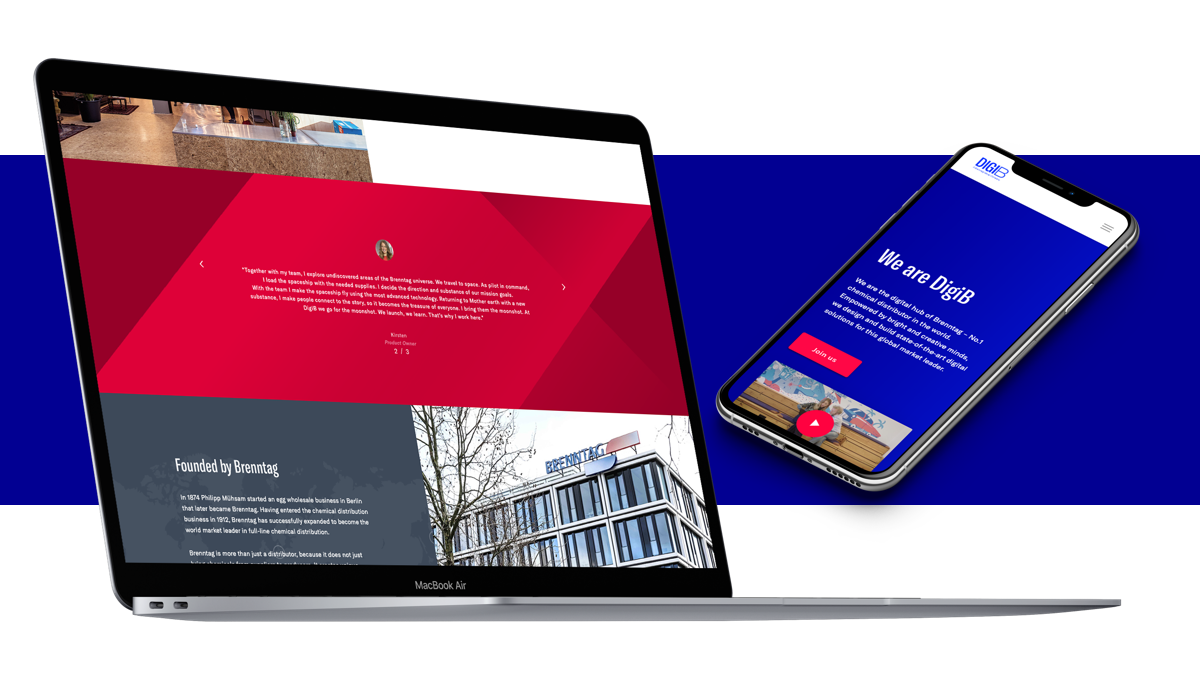
Supplying more information to upsell
When customers are returning to reorder from your company, there is an opportunity to upsell existing products and promote new ones. This goes beyond ‘customers who bought X also bought Y’. This form of personalisation should aim to suggest alterations and explain the reasoning, based on the specific customer’s order. Think of it as a digital representation of the sales rep relationship, understanding the developments in a customer’s business and reacting with new solutions.
It can also be developed into a website feature, an interactive problem solving flowchart or chatbot that allows visitors to input their problem or need and see what solutions the company would suggest.
Optimising site speed
Not every on-site personalisation improvement is interactive and clear for customers to see. Adding in predictive loading is one example, a feature that speeds up the load time for each page on your site based on similar customer journeys.
Customers may never realise that the site they visit uses predictive loading, but they will notice if a site is slow to load. Selling needs to be as smooth as possible; slow loading leads to a larger bounce rate. Installing features, like predictive loading, that uses the information gathered when analysing personalisation can ensure the process never stalls.
Off-site actions
Personalisation also applies to actions that the company makes off-site. Email is one area, automated workflows for customers that left the site without checking can bring them back, boosting conversion through reminders and specialised offers. This can similarly be used for surrounding purchases, following the frequency of repeat purchasing or the typical time it takes for a customer to branch out to a new product.
Also consider how the purchasing journey exists across different touchpoints such as apps, social media and face-to-face meetings. Is it easy to bring up the customer profile and optimise their order based on this information? This kind of integration creates a seamless experience, perfect for B2B’s longer, omnichannel purchasing journeys.
Facilitate an easier commerce experience
In each recommendation, the end goal of facilitating a faster, easier, more accurate commerce experience remains the number one priority. By hitting each aim, the business makes each customer more likely to checkout, more likely to return, and more likely to talk to people in their industry about how great purchasing from your business is. These improvements build up, a snowball effect that ultimately results in increased sales and larger, loyal customer base.
More Insights?
View all InsightsQuestions?
Managing Director UK
Brian Robinson
DEPT® discusses personalisation with Figleaves and Salesforce
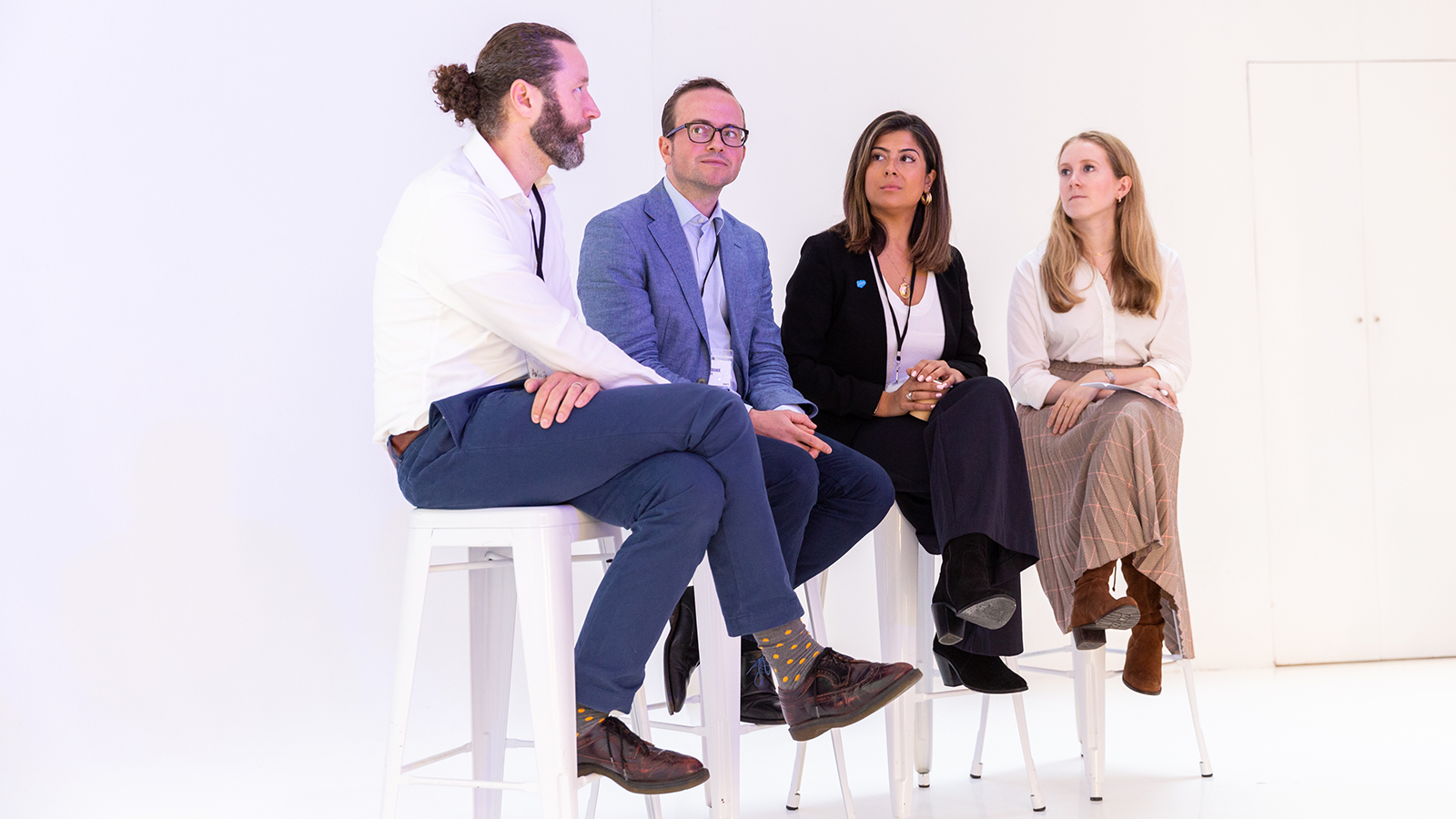
Personalisation is an important pillar of digital marketing strategies. With the rapid evolution of marketing, technology come greater capabilities at the hand of marketers. Investment in MarTech is rising and the bar is set higher. Consumers expect more than a list of products and services when they visit a website. Whether they realise it or not, consumers want businesses to provide them with experiences tailored to their specific needs at that moment.
How brands connect with consumers via personalisation tactics was the topic of discussion amongst panelists at a recent DEPT® event. The panel of Floris Oranje, Managing Director of Managing Director Digital Marketing at DEPT®, Sally Nowroozi, Senior Business Consultant at Salesforce, and Angus Jenkins, Head of E-commerce at Figleaves shared their opinions on the state of personalisation. Diana Pearl, Staff Writer at AdWeek, was the moderator for the breakfast event in London earlier this month.
“Approach personalisation from an audience perspective to serve them better, in a more purposeful way, as a means to understand their needs and guide them through the journey. The approach should be more helpful and less obvious from a sales-perspective”, Sally mentioned, starting the dialogue.
“At Figleaves, there is an added element of complexity, in terms of buying women’s lingerie and supporting the user as they funnel through thousands of intimate products. We don’t want to overload the customer with choice or, equally, compartmentalise them in a space they don’t want to be in. If we narrow down, we run the risk of rejection for being too personalised,” said Angus.
“Previous purchases are our highest value statistic for personalisation, we’re able to get an idea of preferred style, brands, and size. We want our customers to browse and serve up discovery, or else we just become a commodity business and that’s not the brand strategy,” Angus continued to comment.
“Figleaves is bold enough to try different approaches to find out what our audience appreciates and sometimes actions can cause frictions in the UX, or add additional steps. We’ve learnt that it’s all about the execution, ensuring objectives align with relevance.”
A consumer research study conducted by Dept involving 1,000 online shoppers in the UK, reveals one of the most frustrating points with personalisation is being sent recommendations and offers that are not relevant.
Floris said, “This is often as a result of users purchasing an item as a one-off, as a gift, or someone else browsing through their account. The more user-data brands can compile about their customers, ideally first-hand, the more they’re able to accurately tailor touchpoints and enable personalisation to become a useful asset.”
“For instance, customers want to track packages and get updates, but they need to log in and opt-in to be contacted. There needs to be a way to communicate that. We’re constantly battling a balancing act with transparency and how to explain why we need data and what we’re doing with it,” Angus added in agreeance.
“Dynamic data and advancements in MarTech will evolve personalisation, but it needs to be a two-way street with consumers recognising the benefits and providing their details for the sake of personalisation. Connecting the dots between consumer identities, structured and unstructured data will be fundamental for brands to progress, creating an intuitive and channel-less way for brands to speak with customers,” said Floris.
Sally added, “Brands need to stop thinking about personalisation as a project, but use what they have and put on a human hat to incrementally improve design, strategy and marketing. People think of loyalty as a programme, but it’s actually about how you serve your customers and how you define loyalty. Shouldn’t loyalty be defined as a greater definition for the value of engagement?”
When asked how their favourite brands use personalisation, the panellists commended Amazon’s seamless Chatbot feature for easing complicated processes, like returns. The make-up brand Sephora was mentioned for effectively integrating their much-loved, in-store customer service online with a customisable beauty profile. Spotify music player was also acknowledged for ‘getting it right’ for delivering results that don’t feel intrusive.
As an ending note, the trio concluded, a customer’s experience is just as good as the products themselves, and all attempts to connect should be relevant and add value to the consumer.
For more insight on the consumer’s view of personalisation, download DEPT®’s free Whitepaper Report.
More Insights?
View all InsightsQuestions?
Increase your reach with hyper-personalisation in marketing automation
Did you know, over 50% of opened emails are deleted within two seconds. That’s right, we’ve all done it. We all receive emails that we simply don’t care about. You know the kind: irrelevant, impersonal, pushy and sales focused. It’s not often what you want and definitely not what you need. This email was probably auto-generated because companies realise they need to stay in touch with their customers but aren’t sure how to best do this. So, what’s a brand to do?
Start delivering personalised, targeted and contextualised emails with a deeply relevant message. Many marketing automation platforms can actually help you accomplish that. This ensures your email gets read rather than trashed. Personalised emails can improve click-through rates by as much as 14% and can drive revenue by as much as 760%.
Two sides of the same coin
Now, there are two types of personalisation: dynamic and hyper. Dynamic content is the “traditional” version of personalisation. This might include the name, title, organisation and purchase history of a person. This is a good practice, one that many brands already use, but it’s often not enough to capture the user’s attention. However, hyper-personalisation takes this up a notch and utilises behavioural and real-time data to create highly contextual communication that is much more relevant for the consumer.
Let’s look at dynamic personalisation in action. A consumer might receive a basic email from brand X suggesting to them other items they might like. These recommendations are based on their recent purchase(s), browsing history and items that are usually bought together by other customers. Very general information that every brand has access to when a client purchases something on their website.
However, hyper-personalisation is much more tailored. This is the place where all the data comes together. Here an email with recommendations will be based on similar notions as mentioned above. But, there’s more! Website behaviour such as how much time a person spends on each page and items they hovered over are incorporated. Also, recommendations will also be based on gender, age, interests, hobbies and preferences, spending habits in addition to geographical data. For example, if you know the location of the customer you can offer them shop specific promotions. All of this information is combined to provide more relevant content to the consumer transforming them into (hopefully) return customers.
The three-step process
To apply hyper-personalisation to your emails, you can use AMPscripts from Marketing Cloud. AMPscript is a scripting language that you can embed within your HTML emails, text emails, landing pages, SMS messages, and push notifications from MobilePush. The system processes the script at the point where you include it in the message to render content on a subscriber-by-subscriber basis. The Marketing Cloud application handles all AMPscript calls at the end of the email sent.
This tool allows for personalisation per specific subscriber, which means that every subscriber is going to see a different email based on their interest and data.
To best implement this practice, there is a three-step process you can follow.
Personal is better
In an era where individualism is a trend, hyper-personalisation is the key to standing out amongst your competitors. As shown, you can easily implement this practice in three easy steps. And this is just the beginning. If you have all of this data, you can take it to the next level and, say, create a life cycle of tailored emails for consumers from welcoming them, to recommendations and personalised reactivation if needed to keep them interested. You could even take this up a notch and customise website per consumer based on what you know about them, giving them a truly tailored experience across all platforms. As Dale Carnegie once said, “a person’s name is to that person the sweetest and most important sound in any language”.
More Insights?
View all InsightsQuestions?
Managing Director UK













